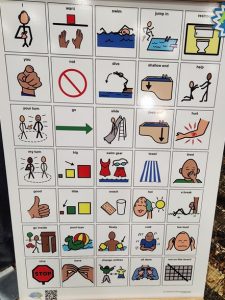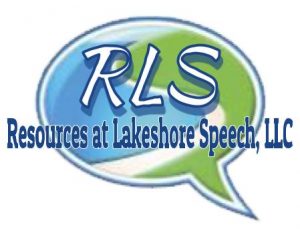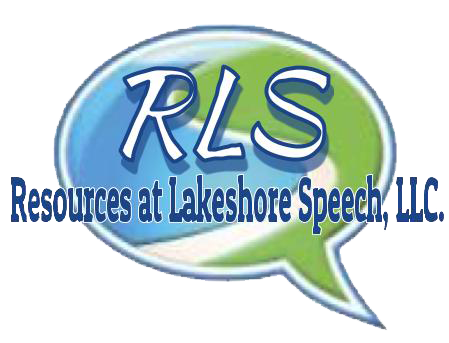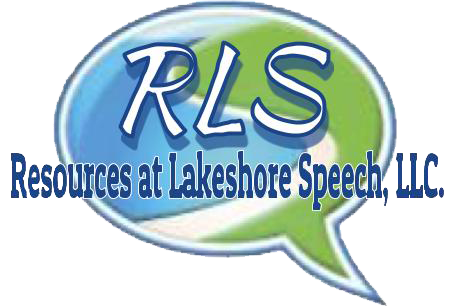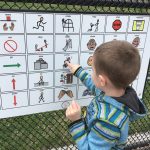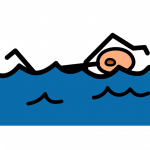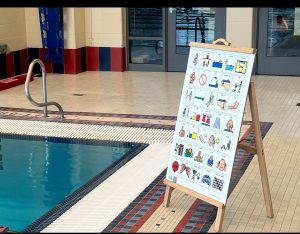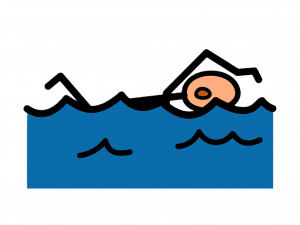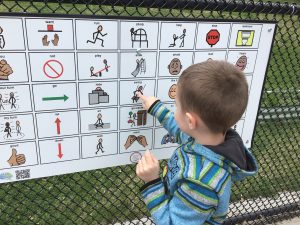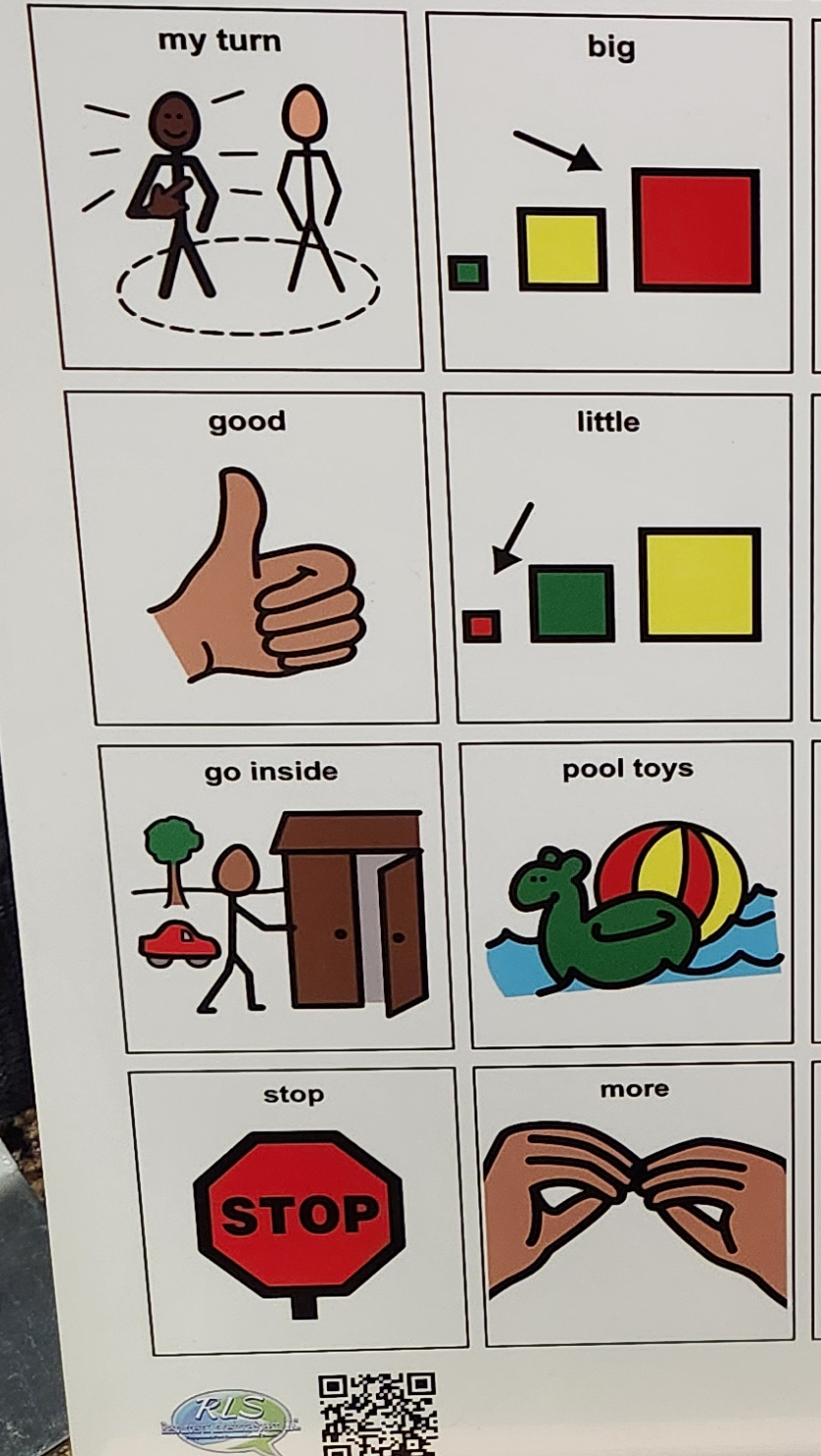
Swimming is a vital life skill, offering fun, fitness, and safety in the water. But for individuals with communication differences, traditional swim lessons can present unique challenges. Many swim instructors may not know how to teach individuals with communication differences, leaving families unsure if their child will be able to participate fully. The good news? Communication boards provide a simple and effective way to make swim lessons more inclusive and successful.
By integrating visual pool communication boards, swim instructors can provide clear, structured guidance that benefits not only individuals with communication differences but all swimmers. In this post, we’ll explore why communication boards are essential in adaptive swim lessons and seven practical ways instructors can use them to teach and ensure water safety.
The Challenge: Teaching Swim Lessons to Individuals with Communication Differences
Individuals with communication differences may face several obstacles in traditional swim lessons:
- Difficulty understanding verbal instructions – Swim lessons often involve fast-paced verbal directions, which can be hard to process.
- Limited ability to ask questions or express concerns – If a child can’t verbally say, “I need a break,” or “I’m scared,” their instructor may not recognize their needs.
- Fear or anxiety in a new setting – Many children feel nervous in the water, and those with communication challenges may struggle to express these emotions.
- Dependence on high-tech communication devices – Many users rely on speech-generating devices, which aren’t waterproof and can’t be used in the pool.
This is where visual communication boards come in! These boards are waterproof, durable, and display key vocabulary using pictures and words so that swimmers with communication differences can understand instructions and communicate their needs.
How Communication Boards Improve Swim Lessons
Here are seven ways communication boards can enhance adaptive swim lessons for both instructors and individuals with communication differences:
Providing Clear, Visual Instructions
Swim instructors typically rely on verbal commands like “Kick your legs!” or “Float on your back!” But for an individual with communication differences, hearing and processing those directions may take longer—or they may not understand at all.
How a Communication Board Helps:
- The instructor can point to an image (e.g., a picture of a swimmer kicking) while saying the command.
- The child can look at the board and visually process what’s expected before attempting the skill.
- This method supports all learners, including those who process information better visually.
Example:*Before practicing floating, the instructor points to an image of a child floating and says, “Now it’s time to float on your back!”
Encouraging Two-Way Communication
Individuals with communication differences may have thoughts, concerns, or requests, but without a way to express them, they can become frustrated or disengaged.
How a Communication Board Helps:
- Swimmers can point to a symbol to indicate if they are tired, cold, scared, or need help.
- Instructors can ask simple questions like, “Do you want to swim more?” and the child can choose ‘Yes’ or ‘No’** from the board.
- Example: A child feels tired but doesn’t know how to express it. They point to “Take a Break” on the board, letting the instructor know they need a short break.
Helping Swimmers Express Emotions
Swimming can be exciting, fun, but also intimidating. Some children may feel overwhelmed, anxious, or frustrated but struggle to express their emotions.
How a Communication Board Helps:
- The board can include a feelings section (e.g., “Happy,” “Scared,” “Excited,” “Frustrated”).
- When a child is nervous about trying a new skill, they can point to “Scared” so the instructor knows to offer reassurance.
- Example: A child points to “Nervous” before trying to put their face in the water. The instructor sees this and says, “It’s okay, we’ll go slow. Let’s just splash first.”
- Making Safety Instructions More Accessible
Water safety is critical and every swimmer needs to understand basic safety rules. However, spoken safety instructions may not always be clear to individuals with communication differences.
How a Communication Board Helps:
- Visual symbol can reinforce key safety rules like:
- “Stay near the wall”
- “Wait for the instructor”
- “No running”
- “Ask for help”
- Swimmers can point to emergency words like “Help” or “Stop” if they feel unsafe.
- Example: The instructor points to the “Stay near the wall” symbol before starting a floating drill, reinforcing the rule visually and verbally.
Supporting Group Swim Lessons
Individuals with communication differences in group swim lessons may struggle to follow instructions or communicate with peers.
How a Communication Board Helps:
- Instructors can use a **large, laminated board** that all swimmers can see.
- Peers can also **point to the board**, helping individuals with communication differences understand what’s happening next.
- Group activities become more **inclusive and interactive** when all children have a shared way to communicate.
- Example: A group lesson includes a game where kids take turns jumping in the water. The instructor points to “Your turn” on the board so the individuals with communication differences knows when to jump.
Helping Swimmers Make Choices
Giving children choices helps them feel **more engaged and in control** of their learning experience.
How a Communication Board Helps:
- The board can include **options for swim activities**, such as:
- “Kickboard”
- “Swim under water”
- “Practice floating”
- Swimmers can **choose what they want to work on** by pointing to an image.
- Example: The instructor asks, “Do you want to practice floating or kicking?” and the child points to “Floating” on the board.
Easing Transitions In and Out of the Water
Many individuals with communication differences users struggle with transitions, such as:
Getting into the pool when they are nervous.
Ending the lesson when they aren’t ready to stop.
How a Communication Board Helps:
- The instructor can point to “First we swim, then we dry off” to explain the sequence of events.
- A countdown visual (e.g., “5 minutes left”) can help swimmers prepare for the lesson to end.
- Example: As the lesson nears the end, the instructor points to “5 more minutes” on the board to give a clear visual warning.
Conclusion
Adaptive swim lessons should be fun, accessible, and safe for all children—includingthose with communication differences. Visual communication boards provide an easy way for swim instructors to give clear instructions, reinforce safety, and support communication needs.
By using communication boards in swim lessons, instructors can:
✅ Make verbal instructions easier to understand
✅ Provide swimmers with a way to express their needs
✅ Reinforce safety rules visually
✅ Create a more inclusive swim environment
If you’re a swim instructor, parent, or community member, advocating for poolside communication boards can help more children access and enjoy swimming.
💬 Have you used communication boards in swim lessons? Let us know how they helped!
